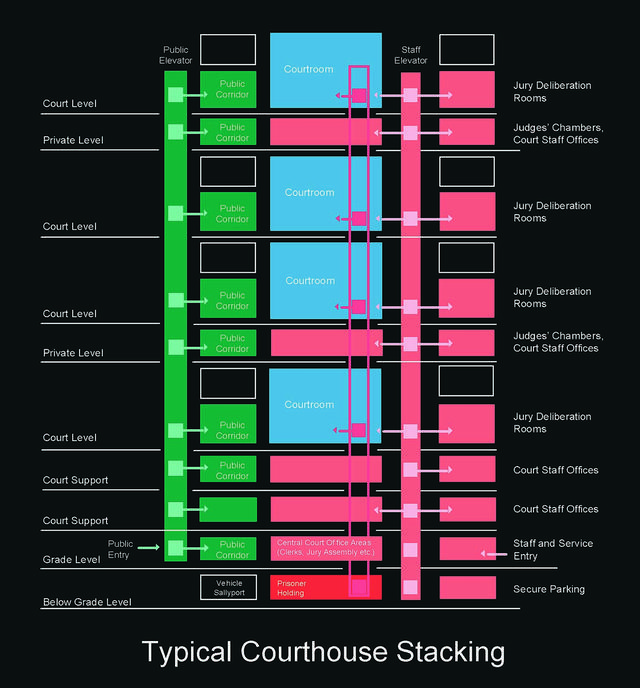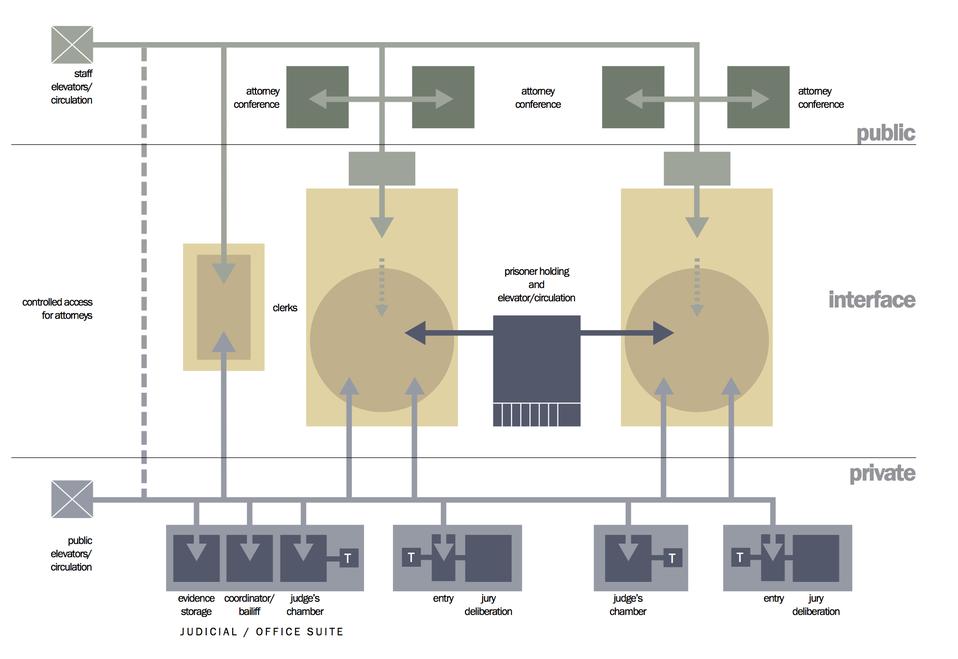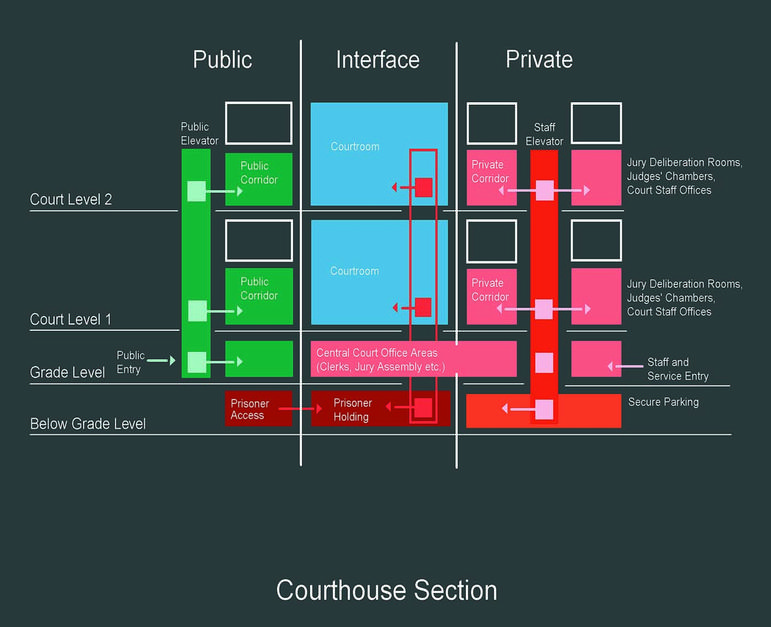Adjacency and Circulation
In architecture, adjacency refers to where various departments and organizations are located in proximity to each other within the courthouse.
Courthouses attract fairly large volumes of public and employee traffic. A large courthouse in an urban setting may accommodate thousands of people during an average day. The location of functions within the facility will dramatically affect how well it operates and how it is perceived by courthouse occupants and members of the community. Issues of public and special access, basic functionalism, security, and image all influence the location of functions within the facility. Although the particular occupants, operating practices, and special needs of jurisdictions vary, and should ultimately control functional locations, there are some general rules.
Locate high-volume functions on lower floors and near the lobby.
Courts that generate a high volume of traffic should be located on the lower floors and have the necessary support offices, such as cashier windows, settlement rooms, witness waiting rooms, and judges’ chambers, nearby. Night courts, if utilized, should be located near a major public entrance, and the rest of the court facility should be inaccessible after hours.
 |
Large courthouses tend to have vertical circulation patterns. Elevators (and in high-volume facilities, escalators) move the public, court officials, employees, jurors, and defendants in custody throughout the facility. But during peak times (8:30-9:30 a.m.,12:00-1:00 p.m., and 4:00-5:00 p.m.) the demand on the public conveyance systems can be overwhelming. Members of the general public transacting non-courtroom business, litigants, witnesses, family members, attorneys, jurors, and court employees may all be competing for elevators at the same time. Locating high-volume service functions on lower floors reduces demands on the elevators, which in turn can reduce frustration levels. High volume functions that benefit from being placed on lower floors:
- Clerk of Court's offices
- Foodservice or vending areas
- Probation offices
- Jury assembly spaces
- High-volume governmental functions (county clerk's office, tax assessor, county treasurer)
- High-volume courtrooms (traffic and arraignment courts)
The convenience of providing easy access to these types of courtrooms, without tying up the elevators, makes these functions good candidates for a lower floor.
Cluster courtrooms on one floor in groups of two, four, six, or eight.
With the exception of traffic and arraignment courts, courtrooms should be located on the upper floors in multi-story buildings, providing quieter and more secure spaces. Even in a very small facility (two floors, for instance), it may be advisable to place higher volume functions on the first floor and courtroom-related functions on the second floor. This minimizes stair or elevator traffic, reduces noise near the courtrooms, enhances security, and permits in-place expansion of individual functions.
Placing courtrooms above functions involving transactional contacts promotes a quieter, more businesslike environment for litigation. It also ensures that only those individuals with a specific court-related business reach the court floors. This expedites elevator traffic and minimizes extraneous security concerns. Segregating courtrooms on higher floors also permits security screening by court floor without interfering with normal transactions. Trial courtrooms generally work best on the upper floors, above the noise and traffic associated with public entrances, lobbies, escalators, and high-volume, short-duration transactions.
Place court-related functions near courtrooms.
Functions that should be close to courtrooms on individual court floors are jury deliberation rooms, courtroom holding facilities, public waiting areas, attorney/client conference rooms, special witness waiting rooms, judges' chambers, and direct judicial support functions, such as judicial assistants or secretaries, law clerks, and court reporters.
Position functions that require after-hours access on the first floor.
Law libraries are not typically high-volume functions. They do, however, have the potential for after-hours access, as do traffic and arraignment courtrooms, probation offices, and court-run education programs. Locating a law library on the first floor of a courthouse permits easy after-hours entry without compromising security for the remainder of the building. The same is true for probation offices that might have clients visiting during the evenings, or a court sponsored traffic safety program that might be required for traffic offenders. As with any location issue, the particular needs and design constraints of the jurisdiction should dictate the actual location.
One of the most difficult transitions that a growing court makes is from the placement of all court functions (judge, jury, clerk of court) on a single floor to the physical separation of court functions on different floors.
Circulation
Courthouse circulation should be simple and direct, and users and visitors should be able to find their way easily throughout the courthouse. The hallmark of good courthouse planning is the development of a building-wide circulation system that provides three separate and distinct paths of movement for the public, court professionals (judiciary and staff), and in-custody accused persons. This controlled circulation should be clear and direct, efficient, and effective; it is essential for both security and safety reasons as well as for the operational efficiency of the court.
 |
Public, Private and Interface Zones |
When renovating older buildings it may be necessary to make some minor compromises in the recommended circulation patterns although it is never acceptable to have in-custody detainees escorted through public spaces.
Public Circulation
Public circulation provides access from main building entrances to the various functional areas of the building. This includes all areas used by the general public, attorneys, clients, witnesses, and jurors (before sequestration), such as the main lobby, corridors, public elevators and escalators, public restrooms, law library, waiting areas, snack bars, clerk of court counters, and reception areas. Anyone with business at the courthouse would use the public circulation zone. It also includes access to the many court and ancillary offices, such as the Prosecuting Attorney, and other offices such as Probation, or the Public Defender. Users of the public circulation include courthouse staff, prosecutors, lawyers, police officers, witnesses, reporters, accused persons who are not in custody, members of the public, persons with business at the clerks’ offices, and courtroom spectators.
The building should have a single main entrance for both public and staff. It is acceptable for the entrance area to include more than one entry point into the queuing zone in front of the security screening; however, all staff and visitors should pass through a single security screening point. Public access should be clearly articulated and direct from the main building entrance to all public destinations within the building.
It is permissible to have an access card by-pass for court staff at the security screening point at the main building entrance.
 |
Private Circulation
Private circulation provides controlled access to particular courthouse users and is not easily or routinely used by the general public. It permits the movement of judges and other trial-related court personnel between chambers and courtrooms, and the movement of sequestered jurors between courtrooms and jury deliberation rooms, without uncontrolled interaction with other courthouse users.
Access to judges' chambers by attorneys, litigants, or others would also typically be controlled.
The judiciary uses the private circulation system for access to secure parking facilities and private elevators, linking with private corridors leading to courtrooms and chambers. Similarly, authorized court staff will use private circulation for access to the courtrooms and judicial offices. All other users must receive specific permission to enter private circulation and must be escorted. On occasion, vulnerable witnesses may be escorted through private circulation and jurors also may be escorted through the private circulation to reach jury deliberation rooms.
The need to separate judges and other court personnel from other courthouse users concerns both security and privacy. Non-trial-related contact may taint either the perception or the reality of neutral and objective adjudication.
Secure Circulation
Secure circulation provides for the movement of defendants in custody. Access to the building should be through a secure vehicular or pedestrian sally port. Defendants in custody are most commonly taken to a secure central holding and staging area before being escorted to individual courtrooms as needed. Where the courthouse is adjacent to a jail or detention facility, it is permissible for in-custody detainees to be brought to the courthouse through a secure walkway. In such situations, the size of the central holding area may be reduced or even eliminated and prisoners escorted directly to the holding areas adjacent to the courtrooms.
Circulation from the central holding area to the individual courtrooms should be by secure elevators to small holding units directly adjacent to the courtrooms. The only quasi-public interface that might occur would involve meetings with defense attorneys in holding areas. This interface may be addressed by allowing attorneys to meet with clients at either the central holding areas or the individual holding facilities adjacent to the courtrooms. Security officers escorting in-custody defendants between the courtrooms and the prisoner handling area will use the secure circulation system. In-custody defendants are not allowed into public or private circulation.
The entire Prisoner Handling Component, including the vehicle sally port, holding cells, control room, staff offices, and ancillary spaces must be treated as a secure entity, along with the secure prisoner circulation system and courtroom holding cells. It must be physically separate from all non-secure spaces and circulation systems in the courthouse.
A secure prisoner elevator that serves holding cells between pairs of courtrooms is the easiest and most efficient method of obtaining direct prisoner access to courtrooms without crossing private judicial/staff corridors and is essential in large multi-storied buildings. By stacking courtrooms, one secure elevator can service four or more courtrooms.
Interface
These are spaces where public, private, and secure zones interact.
Secondary Circulation
There is generally a secondary circulation zone for staff and building services in larger courthouses. This zone is largely contained within the space envelope of the staff areas of the building. The integrity of this zone relies on controlled access between public and private circulation. Included in the service zone are all those spaces that serve as building support areas for the courthouse, such as the receiving dock, program and building storage areas, building maintenance areas, and the mechanical spaces that are accessed in a secondary circulation zone. The entrances to the building through the receiving dock must be secure and access must be controlled. Entry from the public circulation into these areas should be via a door with controlled access.